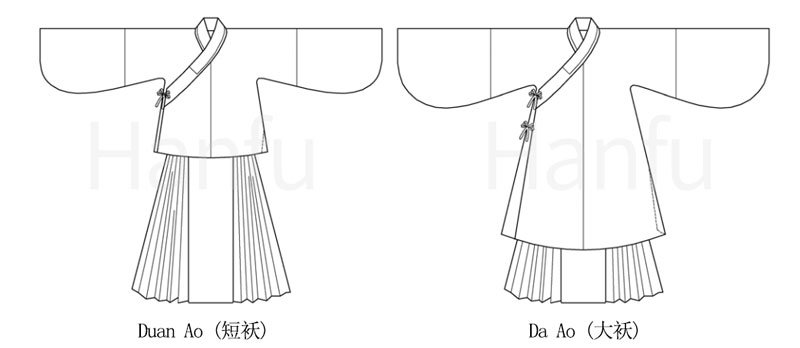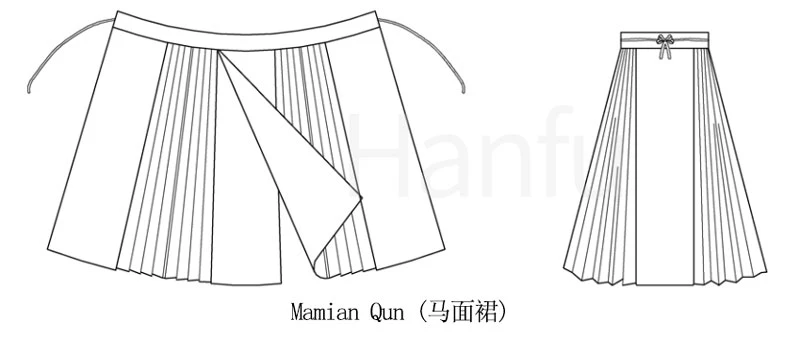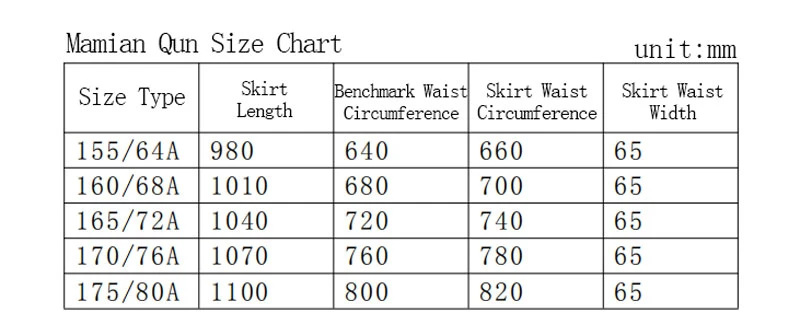This section contains Aoqun (袄裙), which can be divided into: Duan Ao (短袄), Da Ao (大袄), Mamian Qun (马面裙).
Size range: Duan Ao and Da Ao (155/80A to 175/96A), Mamian Qun (155/80A to 175/80A).
Please read the introduction of the topic and how to use this guide in advance.
Introduction
In the Ming Dynasty, women's Hanfu clothing is very popular in the form of clothes cover skirt way of dress, the most common "Aoqun (袄裙)" is a Ming Dynasty women's clothing general term, that is, the upper Ao (袄, jacket) with the lower Qun (裙, skirt) with the way, and not a single piece of clothing. The "Ao" in this section refers to a cross-necked female top, and the "Qun" refers to a Mamian Qun (horse-face skirt).
Early Hanfu tops were mostly called "Ru (襦)", and after the Wei and Jin Dynasties, they were also called "Ao" and "Shan (衫, shirt)". Nowadays, it is generally considered that the Aoqun is longer and covers the waist of the skirt, while the one that requires the clothes to be tucked into the waist of the skirt is the Ruqun (襦裙), but both belong to the Ruqun system.
The Ming-style Aoqun are unique and belong to the mid-waist Ruqun system, which is typical of Shangyi Xiachang (上衣下裳); the outer garment is mostly a pipa sleeve with a narrower sleeve edge (2-3 cm), and the collar is usually white with a collar guard; the lower garment can be a Mamian Qun or a normal pleated skirt.
If the top of the Ao is lengthened to cover the knees, it can be called a "Da Ao". For ease of movement and aesthetics, the top of the Ao is slit on both sides, generally to the crotch and ease of movement.
Mamian Qun is actually made up of two separate skirt pieces that are joined together by a skirt waist, but the two pieces are only partially overlapped and not sewn together directly.
The skirt is not pleated on the left or right side, but is pleated in the middle, with the root of the pleats sewn into the waist of the skirt, and ties are sewn on both ends of the waist, the unpleated parts are overlapped and the pleated parts are naturally spread out, and the number and size of the pleats are based on the actual waist circumference. As the picture shows:
Size chart
Duan Ao (短袄)
Da Ao (大袄)
Mamian Qun (马面裙)
More Hanfu Style Making
Section 1: How to make Zhongyi (中衣)
Section 3: How to make Ruqun (襦裙)
Section 4: How to make Beizi (褙子)
Section 5: How to make Pan collar Aoqun (盘领袄)
Section 6: How to make Quju (曲裾)
Section 7: How to make Banbi (半臂)
Section 8: How to make Shuhe (裋褐)
Section 9: How to make Zhiduo Zhishen Daopao (直裰/直身/道袍)
Section 10: How to make Panling Pao and Lanshan (盘领袍/襕衫)
Section 11: How to make Shenyi (深衣)
Section 12: How to make Yisan (曳撒)
Section 13: How to make improved Hanfu (改良汉服)












Is there a printable pdf pattern?
The math doesn’t seem to add up on a lot of these. Did anybody figure these out? Especially the pleat measurements. Also, why do we need two pieces of cloth in the beginning?
The two pieces of cloth are probably because a mamianqun opens in the back and front, im pretty sure
Thank you for the guide, but I am confused! In the first set of patterns 155/64A Duan Ao Detail Size Drawings - the left lapel has 490 in height along the longer part. Shouldn't it be 460? Or where should I sew it to? I combined them in Photoshop and they seem the same length , but one label is 460 and the other one is 490.
Thanks for the guide, but may I ask why two pieces of fabric are used in the first step for the mamian skirt? I'm very sorry if it's said within the article and I just overlooked it
Thanks for the guide👍
The schematic for the pleats are so helpful!
Artikel yang bagus, perlu dicoba bikin baju sendiri. Thanks